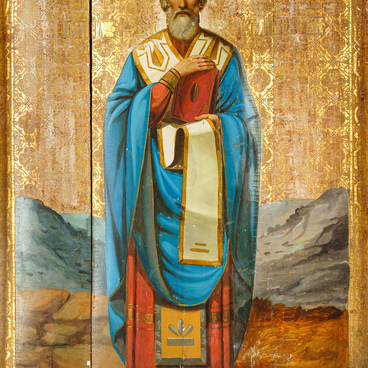A banner, also known in Russian as “a khorugv, ” is a church “standard” mounted on a tall pole. Unlike regular flags, a khorugv does not fall in folds but maintains its shape due to a crossbar to which its upper part is attached. Typically, icons are depicted on khorugvs. They can be made from both fabric and metal.
The khorugvs we see in every Orthodox church trace their origins back to ancient Roman military standards. Today, khorugvs are primarily carried in processions. In the Imperial Russian Army, standards with sacred images and khorugvs were present in every regiment. They often depicted saints — heavenly patrons of military units — as well as the Savior (most commonly the image of the Mandilion (the Savior Not Made By Hands)) and the Virgin Mary.
The exhibit at the Museum of Sarov is made of brass using the method of cutting out from a solid thin sheet of brass, followed by polishing the item to a mirror finish. The museum piece is double-sided, with the Ascension of the Lord depicted on one side and Saint Nicholas the Wonderworker on the other.
The icon in the center of the khorugv is missing; previously, an image in the form of a lithograph was inserted into the middle of the brass frame. Typically, this would be the face of Christ or the Virgin Mary, but images of saints or church feasts were also possible. Icons adorned with brass framing were carried on tall poles, topped with a cross-shaped finial.
Saint Nicholas the Wonderworker is a revered saint in Orthodox Church, the patron of sailors, travelers, orphans, and prisoners. A servant and a benefactor of the Lord, Saint Nicholas is known for his many miracles and compassion for people. He healed the sick, saved people from misfortunes and unjust accusations, and gave alms to the poor. He protected sailors with his prayers.
Saint Nicholas was born in
Lycia, in the city of Patara, around the second half of the 3rd century AD. He
had a gentle character, was kind and patient. However, this did not prevent him
from zealously defending the faith, destroying pagan temples, and denouncing
heretics. The saint lived to a ripe old age. His relics were found to be
incorrupt and exuded healing oil.





